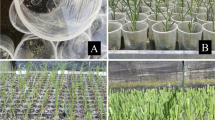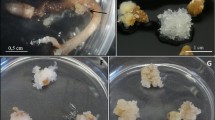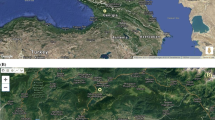Abstract
Key message
Temporary immersion bioreactors can improve hybrid sweetgum somatic embryo conversion and somatic seedling growth rates compared to semisolid medium, significantly improving somatic seedling production efficiency for hybrid sweetgum, an emerging woody biomass crop.
Abstract
Fast-growing hybrid southern hardwood trees should make excellent material for woody biomass production in the Southeastern US, if elite clones can be identified and efficiently propagated. We have enhanced the potential of sweetgum (Liquidambar styraciflua) as a biomass species by generating hybrids between the tree and its Chinese relative, Liquidambar formosana, and propagating the most promising clones via somatic embryogenesis. Some of the hybrid clones have already demonstrated superior biomass productivity compared to elite L. styraciflua trees. However, production of somatic seedlings from these clones remains labor-intensive. Bioreactors, specifically temporary immersion designs, such as the RITA®, have been applied to improve the efficiency of in vitro propagation of a number of woody species. We tested RITA® bioreactors for their potential to improve the production efficiency of high-quality hybrid sweetgum somatic seedlings. In one tested genotype, a RITA® with 50 somatic embryos had about 66% higher conversion frequency (p < 0.05) and produced about 40% more “high-quality” somatic seedlings (p < 0.05) than when somatic embryos were germinated on semisolid medium in GA-7 vessels. In all the genotypes we tested, somatic seedlings produced in RITA® bioreactors had higher survival percentages by the end of acclimatization than somatic seedlings produced on semisolid medium in GA-7 vessels.







Similar content being viewed by others
References
Albarrán J, Bertrand B, Lartaud M, Etienne H (2005) Cycle characteristics in a temporary immersion bioreactor affect regeneration, morphology, water and mineral status of coffee (Coffea arabica) somatic embryos. Plant Cell Tiss Org Cult 81:27–36
Cabasson C, Alvard D, Dambier D et al (1997) Improvement of Citrus somatic embryo development by temporary immersion. Plant Cell Tiss Org Cult 50:33–37. https://doi.org/10.1023/a:1005896725780
Chen C (2016) Cost analysis of plant micropropagation of Phalaenopsis. Plant Cell Tiss Org Cult 126:167–175
Dai J, Vendrame WA, Merkle SA (2004) Enhancing the productivity of hybrid yellow-poplar and hybrid sweetgum embryogenic cultures. In Vitro Cell Dev Biol Plant 40:376–383
Escalant J-V, Teisson C, Côte F (1994) Amplified somatic embryogenesis from male flowers of triploid banana and plantain cultivars (Musa spp.). In Vitro Cell Dev Biol Plant 30:181–186
Etienne H, Berthouly M (2002) Temporary immersion systems in plant micropropagation. Plant Cell Tiss Org Cult 69:215–231
Etienne H, Lartaud M, Michaux-Ferrière N et al (1997) Improvement of somatic embryogenesis in Hevea brasiliensis (Müll. Arg.) using the temporary immersion technique. In Vitro Cell Dev Biol Plant 33:81–87
Etienne-Barry D, Bertrand B, Vasquez N, Etienne H (1999) Direct sowing of Coffea arabica somatic embryos mass-produced in a bioreactor and regeneration of plants. Plant Cell Rep 19:111–117
Gao M, Jiang W, Wei S et al (2015) High-efficiency propagation of Chinese water chestnut [Eleocharis dulcis (Burm.f.) Trin. ex Hensch] using a temporary immersion bioreactor system. Plant Cell Tiss Org Cult 121:761–772
Gresshoff PM, Doy CH (1972) Development and differentiation of haploid Lycopersicon esculentum (tomato). Planta 107:161–170
Hlophe N, Moyo M, Staden J, Finnie J (2015) Micropropagation of Zantedeschia aethiopica (L.) spreng.: towards its commercial use in the cut flower industry. Propag Ornam Plants 15:73–78
Holtz CT (2014) Enhancing chestnut embryogenic culture productivity and somatic embryo quality by targeting steps in the embryogenesis protocol. M.S. Thesis, University of Georgia, Athens, GA USA
Huxter TJ, Thorpe TA, Reid DM (1981) Shoot initiation in light-and dark-grown tobacco callus: the role of ethylene. Physiol Plant 53:319–326
Kitto SL (1997) Commercial micropropagation. HortScience 23:1012–1014
Kosky R, Perozo J, Valero N, Peñalver D (2005) Somatic embryo germination of Psidium guajava L. in the RITA® temporary immersion system and on semisolid medium. Liq Cult Syst In Vitro Plant Propag. https://doi.org/10.1007/1-4020-3200-5_14
Lal M, Tiwari A, Gupta G (2015) Commercial scale micropropagation of sugarcane: constraints and remedies. Sugar Tech 17:339–347
Loyola-Vargas VM, Avilez-Montalvo JR, Avilés-Montalvo RN et al (2016) Somatic embryogenesis in Coffea spp. In: Loyola-Vargas VM, Ochoa-Alejo N (eds) Somatic embryogenesis: fundamental aspects and applications. Springer International Publishing, Cham, pp 241–266
Ma J-H, Yao J-L, Cohen D, Morris B (1998) Ethylene inhibitors enhance in vitro root formation from apple shoot cultures. Plant Cell Rep 17:211–214
Mallón R, Covelo P, Vieitez AM (2012) Improving secondary embryogenesis in Quercus robur: application of temporary immersion for mass propagation. Trees 26:731–741. https://doi.org/10.1007/s00468-011-0639-6
Mamun N, Egertsdotter U, Aidun C (2015) Bioreactor technology for clonal propagation of plants and metabolite production. Front Biol 10:177–193
McAlister B, Finnie J, Watt MP, Blakeway F (2005) Use of the temporary immersion bioreactor system (RITA®) for production of commercial Eucalyptus clones in Mondi Forests (SA). Plant Cell Tissue Org Cult 81:347–358
Merkle S (2018) The ups and downs of developing hybrid sweetgum varieties for the US bioenergy and pulp and paper industries: a 20-year case study. In: Bonga JM, Park YS, Trontin JF (eds) Proceedings of the 5th international conference of the IUFRO Unit 20902 on “Clonal Trees in the Bioeconomy Age: Opportunities and Challenges”, Coimbra, pp 225–229
Merkle S, Cunningham M (2011) Southern hardwood varietal forestry: a new approach to short-rotation woody crops for biomass energy. J For 109:7–14
Merkle SA, Cunningham M (2016) Application of hybrid breeding and somatic embryogenesis to develop sweetgum varieties for the bioenergy and pulp and paper industries. In: Adams J (ed) 33rd Southern forest tree improvement conference, Hot Springs, AR pp 55–57
Merkle SA, Montello PM, Kormanik T, Le H (2010) Propagation of novel hybrid sweetgum phenotypes for ornamental use via somatic embryogenesis. Propag Ornam Plants 10:220–226
Michoux F, Ahmad N, Hennig A et al (2013) Production of leafy biomass using temporary immersion bioreactors: an alternative platform to express proteins in transplastomic plants with drastic phenotypes. Planta 237:903–908
Murashige T, Skoog F (1962) A revised medium for rapid growth and bio assays with tobacco tissue cultures. Physiol Plant 15:473–497
Nasri A, Baklouti E, Romdhane AB, Maalej M, Schumacher HM, Drira N, Fki L (2019) Large-scale propagation of Myrobolan (Prunus cerasifera) in RITA® bioreactors and ISSR-based assessment of genetic conformity. Sci Hort 245:144–153
Quiala E, Cañal MJ, Meijón M et al (2012) Morphological and physiological responses of proliferating shoots of teak to temporary immersion and BA treatments. Plant Cell Tissue Org Cult 109:223–234
Sommer HE, Brown CL (1980) Embryogenesis in tissue cultures of sweetgum. For Sci 26(2):257–260
Vendrame WA, Holliday CP, Merkle SA (2001) Clonal propagation of hybrid sweetgum (Liquidambar styraciflua × L. formosana) by somatic embryogenesis. Plant Cell Rep 20:691–695
Vidal N, Sanchez C (2019) Use of bioreactor systems in the propagation of forest trees. Eng Life Sci 19:896–915
Vidal N, Blanco B, Cuenca B (2015) A temporary immersion system for micropropagation of axillary shoots of hybrid chestnut. Plant Cell Tissue Org Cult 123:229–243
Witham FH, Blaydes DF, Devlin RM (1971) Experiments in plant physiology. Van Nostrand Reinhold Co., New York
Wright J, Cunningham M (2008) Sweetgum plantations for sawtimber, energy, pulp, and other uses. For Landowner 67(3):26–28
Acknowledgements
The research reported here was supported by ArborGen Inc. The authors would like to thank Paul Montello for his work on hybrid sweetgum embryogenic culture initiation and maintenance, and Christine Holtz and Lisheng Kong for instruction on RITA® operation.
Author information
Authors and Affiliations
Corresponding author
Ethics declarations
Conflict of interest
The authors declare that they have no conflict of interest.
Additional information
Communicated by Klimaszewska.
Publisher's Note
Springer Nature remains neutral with regard to jurisdictional claims in published maps and institutional affiliations.
Electronic supplementary material
Below is the link to the electronic supplementary material.
Rights and permissions
About this article
Cite this article
Lu, S., Merkle, S.A. Enhancing hybrid Liquidambar somatic seedling production using a temporary immersion bioreactor. Trees 35, 503–512 (2021). https://doi.org/10.1007/s00468-020-02052-0
Received:
Accepted:
Published:
Issue Date:
DOI: https://doi.org/10.1007/s00468-020-02052-0




